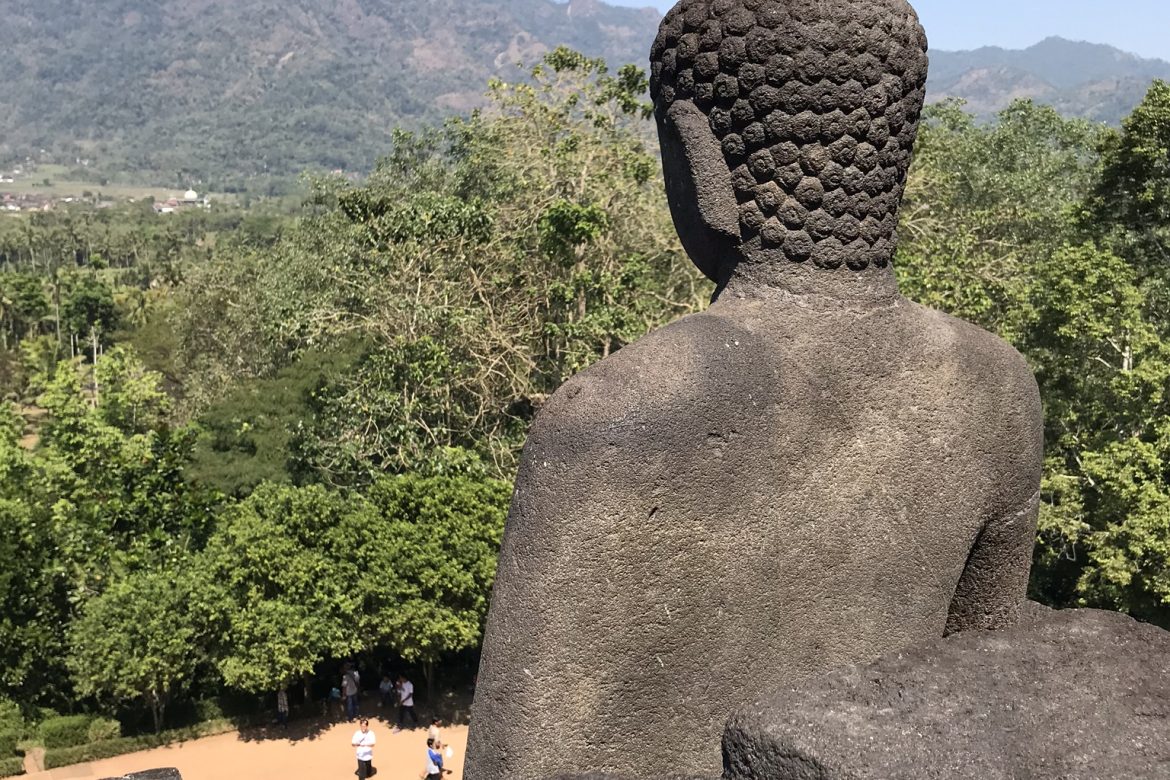
Yogjakarta/Central Java
Yogja is a special place.
We came here to find out the soul of Java and therefore an important part of modern Indonesia. It’s where school students from all over the archipelago dream to go on their school trips. My Indonesian tutor Gusde was so excited to hear I wanted to go there, and quickly gave me a list of things to see and do. Indonesia is a diverse land of many cultural groups and within its short history of being a united nation, Yogja is super special as it has been an important symbol of resistance to colonial rule. All over Indonesia you can see grand streets named Jalan Diponegoro- this was the name of Prince who from 1825-1830 waged the Java War. It was the capital of the republic from 1946 until independence in 1949. A very cool story is that when the Dutch reoccupied Yogya in 1948, the sultam locked himself in the kraton (walled palace) and let rebels use the area as headquarters. The Dutch did not dare to upset the sultan, as if they did they would have the fury of millions of Javanese upon them, as they consider the sultan to be almost a living god. When Indonesia declared independence, Yogja was rewarded and granted the status of special region.
So very special, indeed!
Yogkakarta/Yogya/Jogja (interchangeable and all perfectly acceptable)
We arrived in the evening. Our hotel was located a five minute walk from Marliboro Street- the main shopping thoroughfare and at this time, it was a pedestrian zone. This is the city’s main street, and was once the ceremonial avenue for the Sultan to pass through on his way to and from the Kraton/Keraton. Near the north gate of the Keraton or palace are grand Dutch colonial buildings that are now the Central Post Office and the Bank Dagang Negara. Walking further north is the well-laid-out State Guest House, which was once the home of the Dutch Resident, but which after Independence became the presidential palace when Yogya was the capital of the young Republic. President Soekarno stayed here between 1946-1949. Some say that the name “Malioboro” derives from the name of the British governor Marlborough from the era when Britain ruled the archipelago, between 1811-1816. I loved the old-style shops with the shelves behind the counter. I bought a cushion with the Teh Kotak image on it. J insisted E and I buy long pants as wearing our shorts was very prominent amongst the throngs of shoppers and families and people just nongkrong– hanging out with their friends. There were lots of opportunities to buy batik items here.
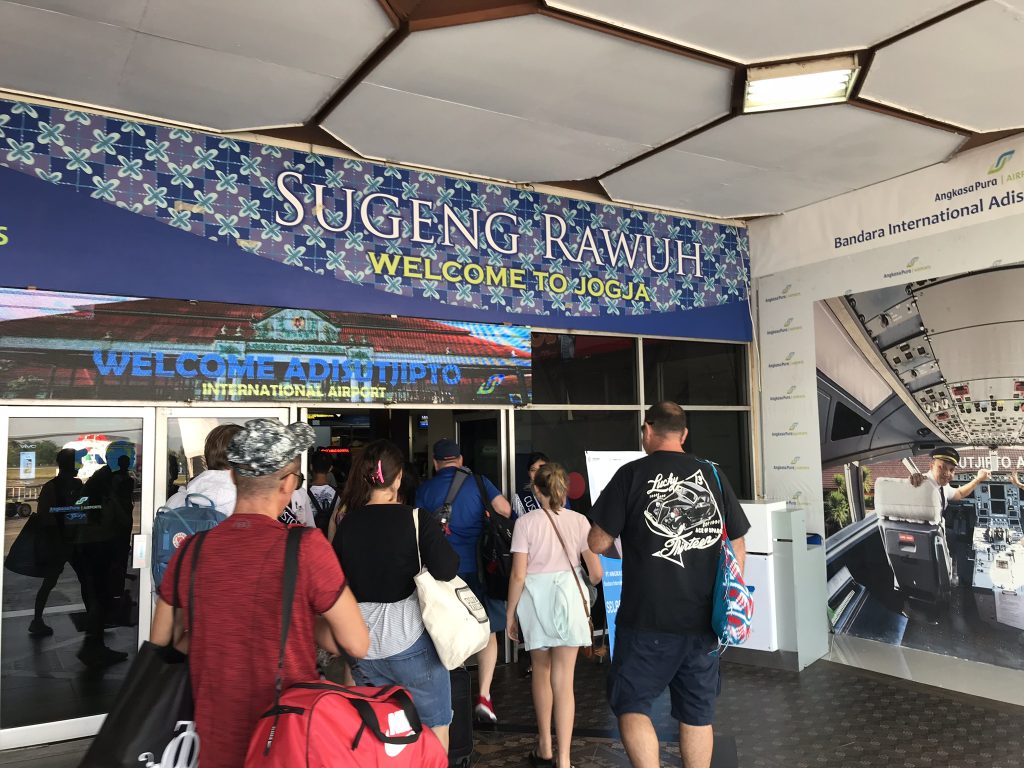
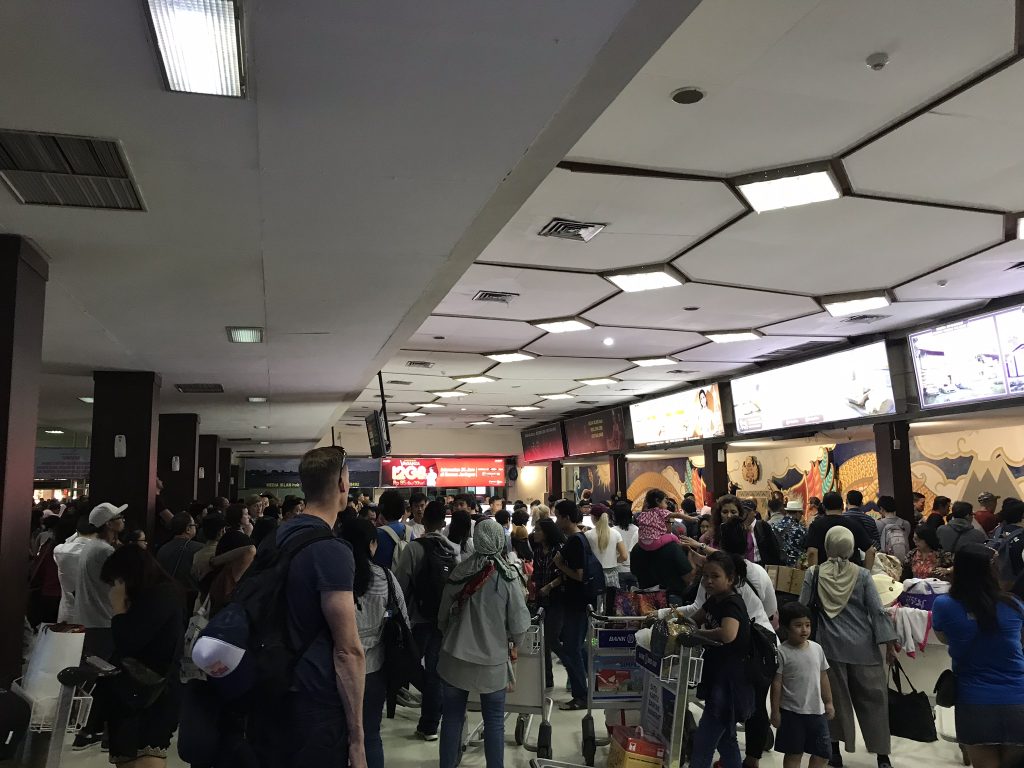
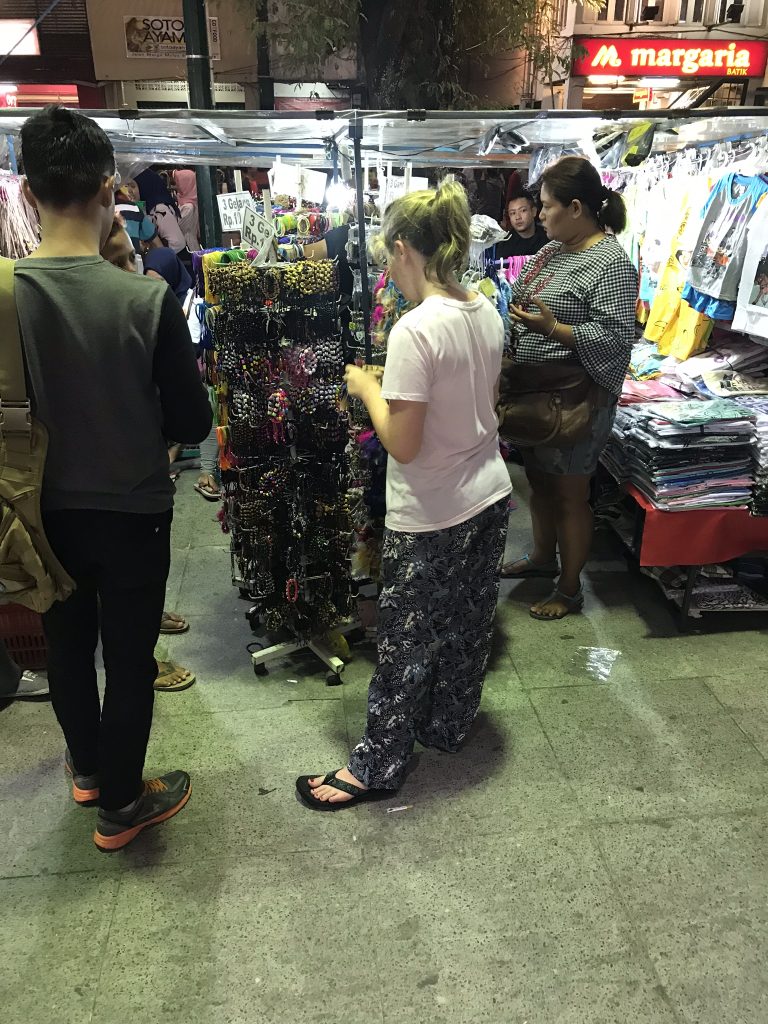
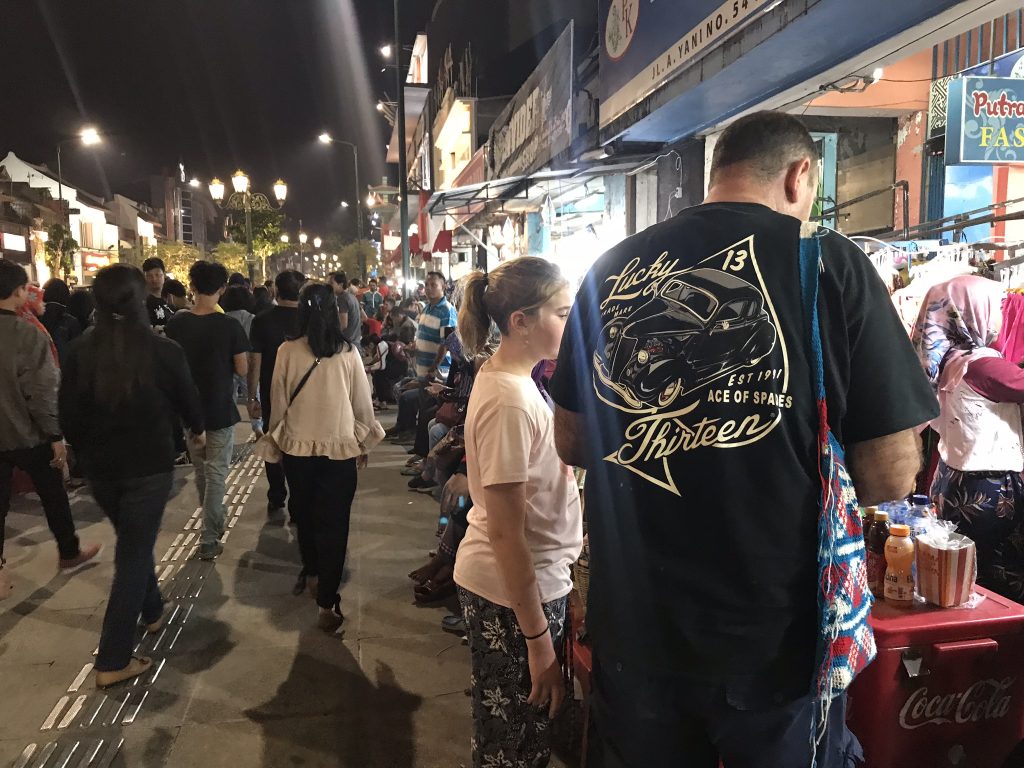
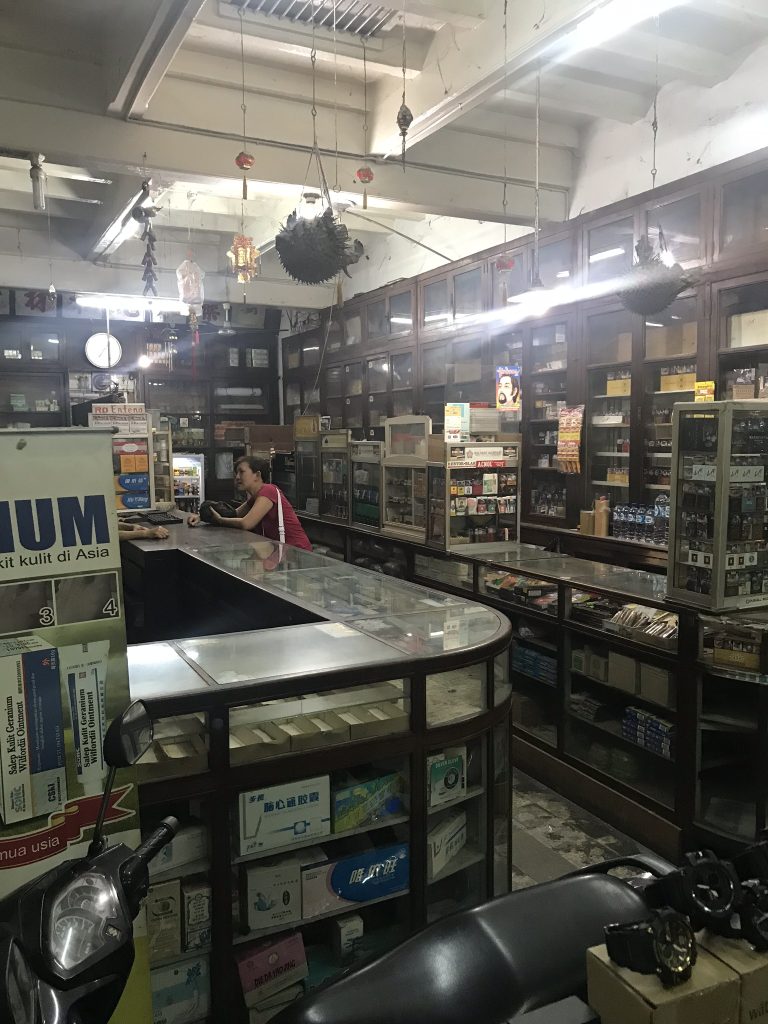
The Kraton (Sultan’s palace)
Yogja’s Kraton (palace) is like a walled city within the city of Yogja. It comprises of a series of halls, courtyards and pavilions built between 1755 and 1756. The innermost complex is off limits as the sultan still lives here. At the centre of the Kraton is the Bangsal Kencana, The Golden Pavilion. It is where the current sultan receives important guests. It has a marble floor and a beautifully decorated roof. There were gamelan playing and people wandering around- no sign of the sultan. He was probably in London.
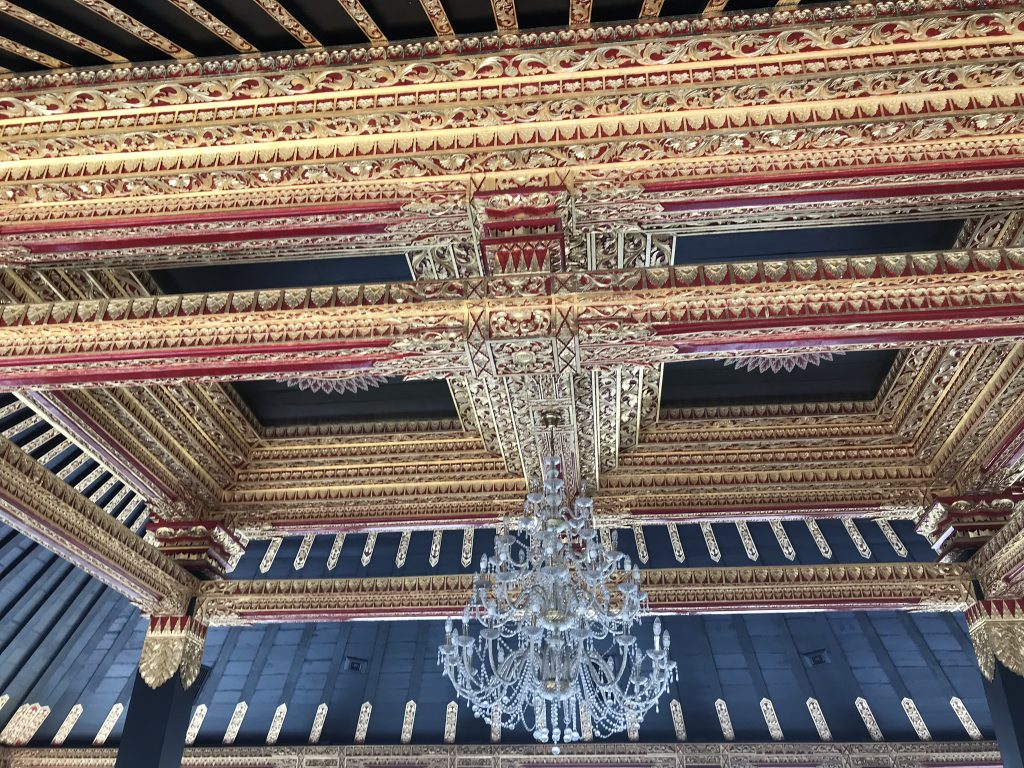
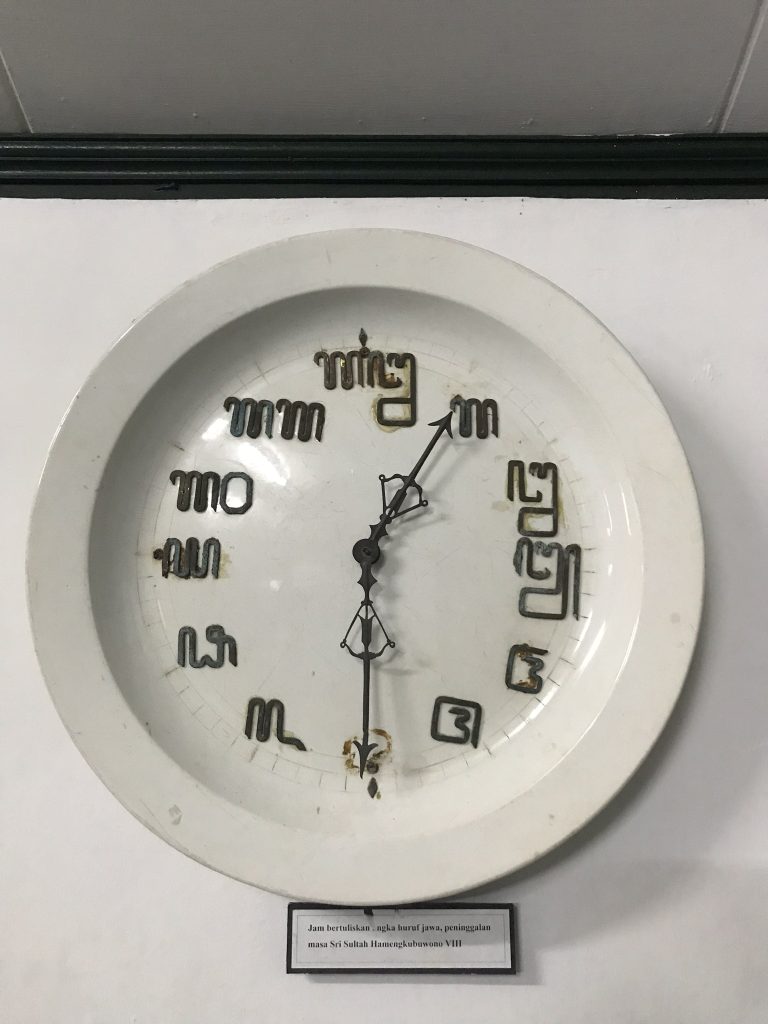
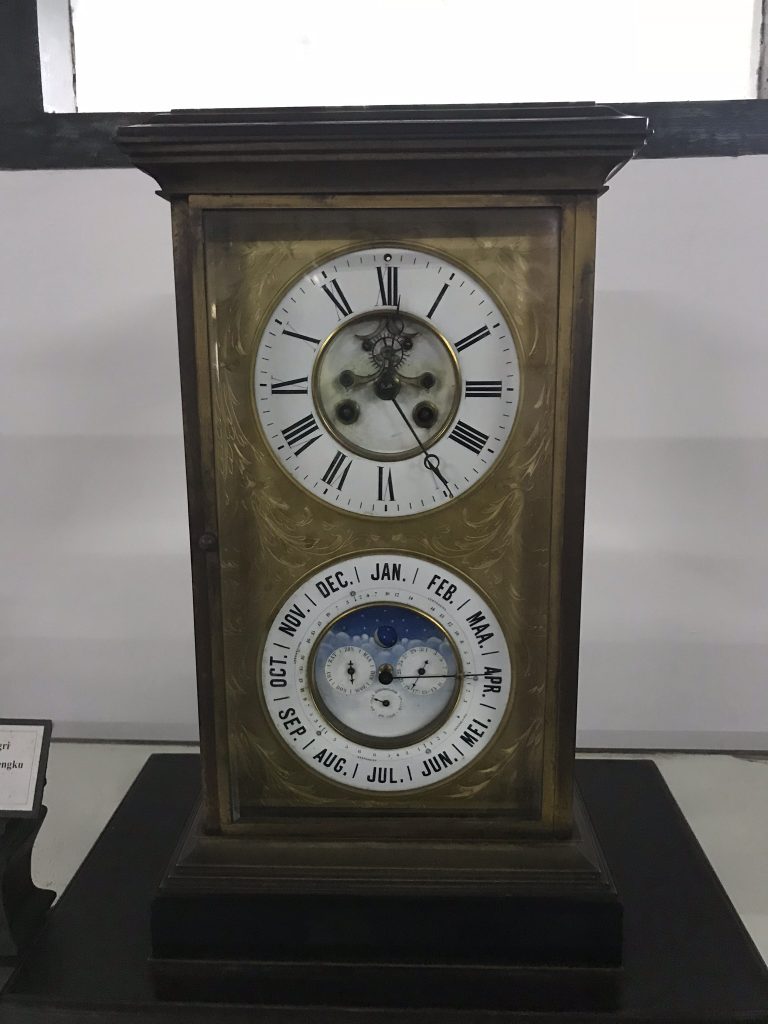
Outside the Kraton at the centre of the northern square there are two sacred banyan trees- the waringin. In the days of feudal Java, petitioners would wait here hoping to gain an audience with the sultan. In the southern square are the two trees which brought us to Yogja in the first place. My Indonesian tutor Gusde was so excited when he heard we were visiting the old capital and insisted I try this out. Two banyan trees are said to bring great fortune to those who can walk blindfolded through them without having any mishaps or misfortunes. Gusde came here on his honeymoon to walk through with his new wife to make sure their marriage would be a good one. Perhaps a little late, Gusde seeing you were already married. He has two lovely children now so I guess they walked through without incident!
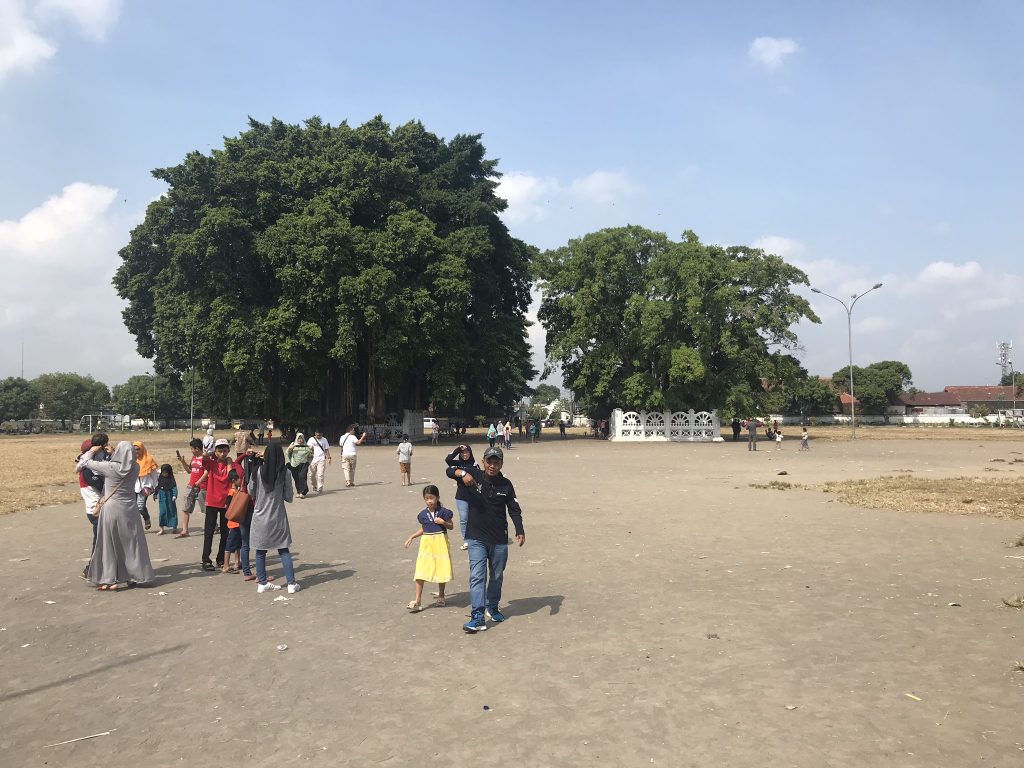
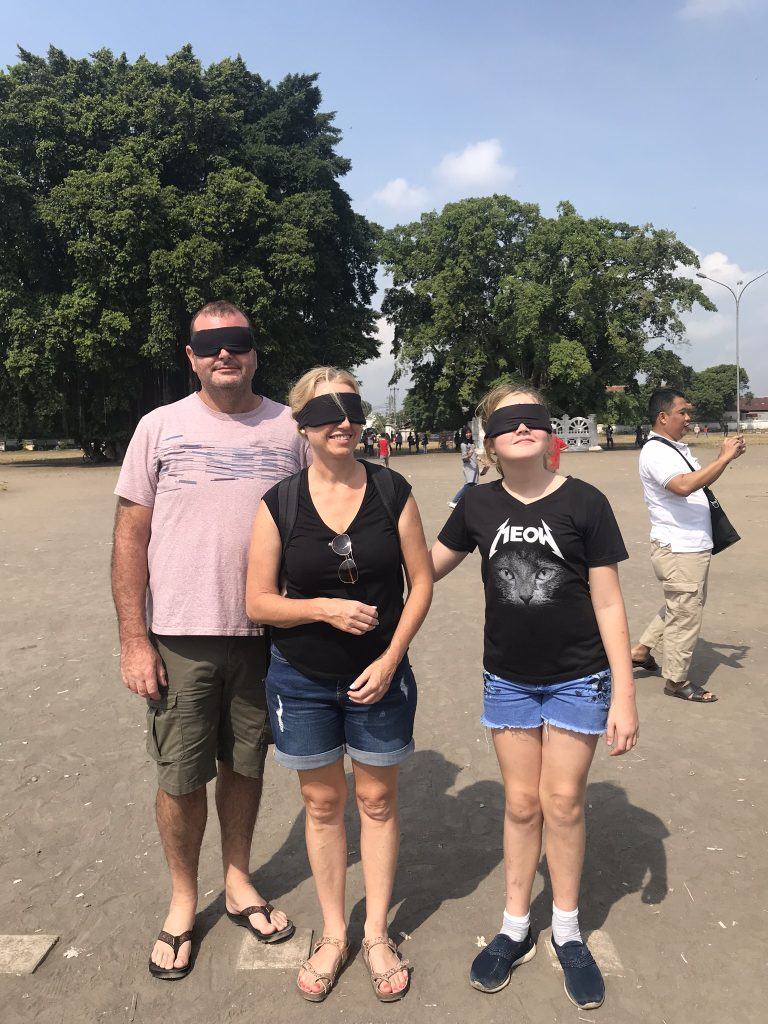
Borobudur

On our second day in Yogja we visited, along with about 20,000 other people, (it is the end of Ramadan, when many people take their holidays) the spectacular Borobudur temple complex, about 40km ( 2-3 hours drive with Traffic) from our home base of Yogyakarta.
Most of the other visitors were locals and there were only a handful of foreigners so we make sure we were very well covered up. This did not stop us from being photographed and filmed, which we found creepy. The greatest hazards we found there were getting poked in the eye by parasols or being concussed with a wayward selfie stick.
A UNESCO world heritage site, the temple was said to be built in the ninth century and rediscovered in 1815 by Raffles when he was governor of Java. There have been major restoration efforts since then, despite earthquakes, volcanic ash, terrorist bombs and rampant tourism.
The dry stone walling with gaps is to withstand earthquakes . It is actually built like a giant Lego tower; all the pieces fit together without concrete.
Borobudur is the world’s largest Buddhist temple. The temple consists of nine stacked platforms, six square and three circular, topped by a central dome. It is decorated with 2,672 relief panels and 504 Buddha statues. Some have body parts missing. The central dome is surrounded by 72 Buddha statues, each seated inside a perforated stupa.

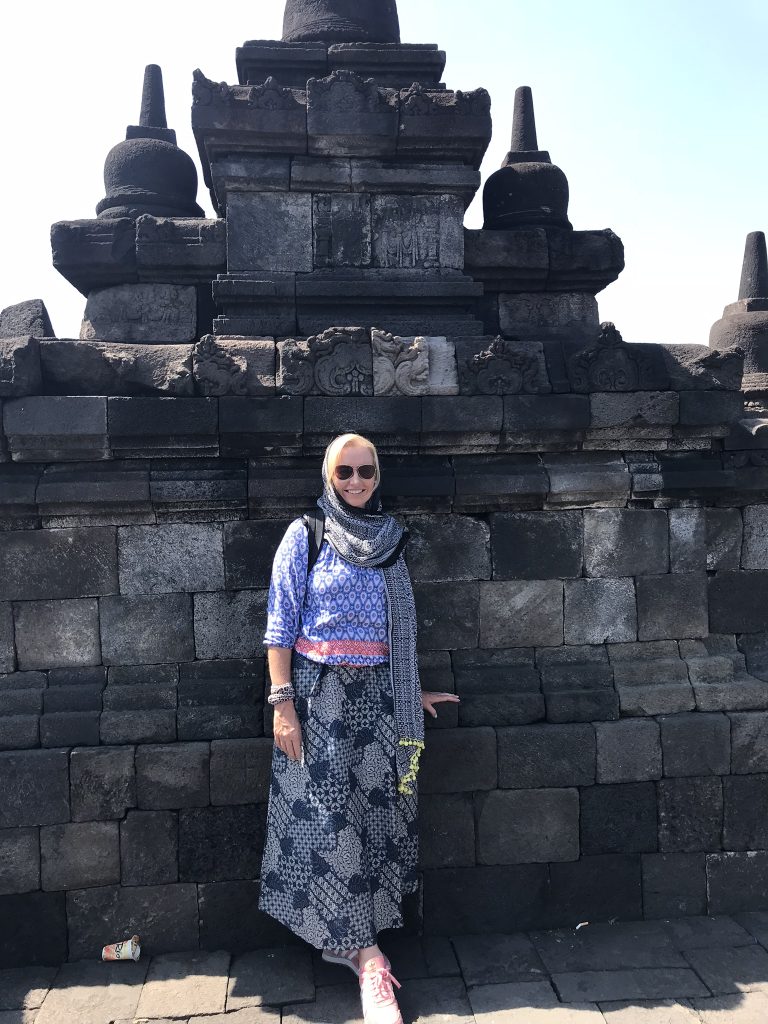


Our guide was very gracious, explaining the stories of Buddha and the path to enlightenment which unfortunately today was difficult to attain due to the sheer volume of people needing to take a selfie before reaching nirvana. We liked it when he told people off for climbing on the statues.
Despite the heat and crowds, it was a truly humbling and magical experience and we feel very lucky to have seen it with our own eyes, bearing witness to the incredible workmanship of the structure and the rich and abiding stories that the reliefs can tell us- much like a collection of stories from people who once walked the paths we did today.


We have a lovely driver named Yusef who today on our drive pointed out the natural bounty of the beautiful island of Java. We saw the following crops and trees; peanuts, mahogany, rice, rambutan, maize, various types of chilli, papaya, tamarind, durian, cassava (used to make tapioca), teak, Javanese orange ( the leaves are crushed to make a red dye for makeup), and there were quails scuttling though the orange groves. Peanuts take 90 days to grow, rice 100 days. The teak trees were quite spindly; they take 30 years to mature. We saw the canal systems made from the Progo River which flows from Mount Sumbing ( next to Mt Sondoro) and it is not nearly as polluted as in Bali. At the base of Borobudur the guide showed us cinnamon and clove trees. There was no fruit, but if you rub the leaves the smell of the oil can identify the tree. I was most excited by my first encounter with a real, live nutmeg tree, once only found in the Spice Islands to the north east of Java, and the reason why the Dutch and English were in conflict during the age of ‘exploration’. In 1667 they called a truce; the Dutch were ceded the tiny island of Run- in exchange the English were given the island of Manhattan!
Taman Sari
After a quick roadside lunch (chose the vegetarian option after seeing the fish head stews and felt vindicated after seeing the ponds in which they are bred on the way) and a nap in the car on the way back to Yogya from Borobudur, we stopped at the Taman Sari ( beautiful garden) Palace complex, on the the site of a former royal garden of the Sultanate of Yogyakarta.
Built in the mid-18th century, the Taman Sari had multiple functions, such as a resting area, a workshop, a meditation area, a defense area, and a hiding place. A bit hard to hide nowadays; it is full of shops selling souvenirs and yet another place one can easily lose an eye with a wayward selfie stick.
At Taman Sari we saw 2 different kinds of Mango tree, an inedible cotton tree (the inside is used to stuff pillows), and a decorative fruit called the Buddha’s hair. There is also a small berry which is actually a member of the citrus family, growing from a bush in a pot near the natural spring pool, and was used as lipstick and nail polish by the wives of the Sultan by crushing them and rubbing the juice into nails and skin. They also had a method for creating a mirror without glass: in an earthenware pot, place two-thirds with black volcanic sand, then fill with water and allow to settle. The result is a natural looking glass! Please feel free to correct any of my observational mistakes- I am merely repeating what I was told today! I thoroughly enjoyed my natural history lessons.
I am really enjoying the bright colours of Yogya and the vibrant street art.
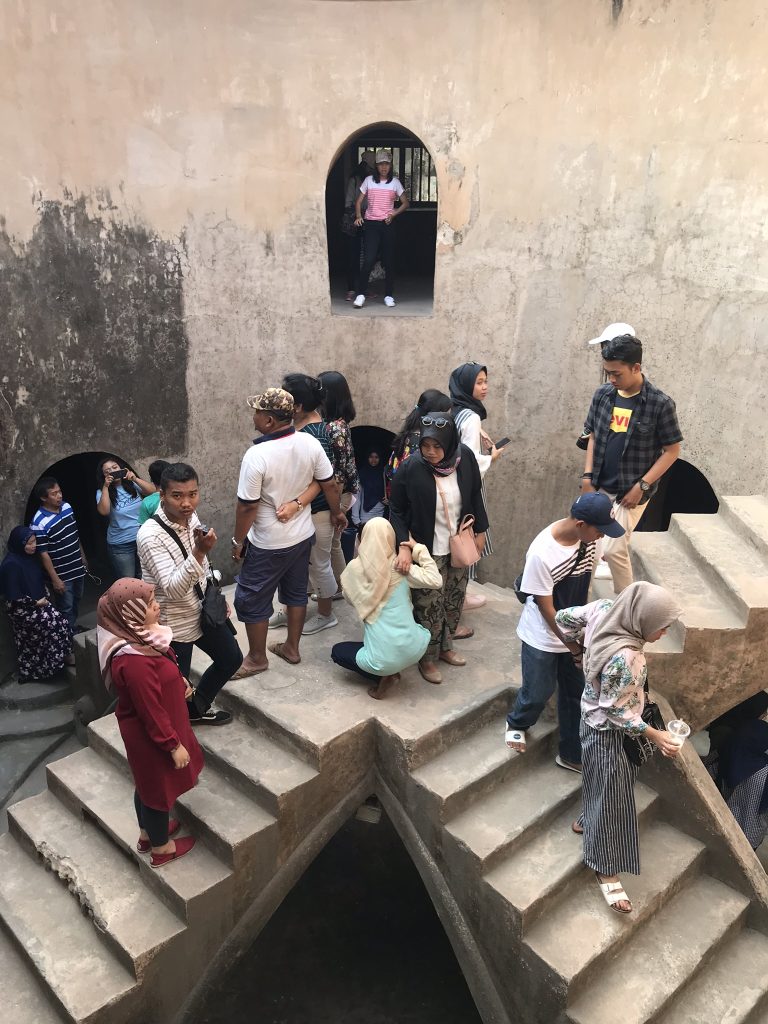





Prambanan
Comprising the remains of some 244 temples, World Heritage–listed Prambanan is Indonesia’s largest Hindu site. The highlight is its central compound, where its eight main and eight minor temples rise up majestically like ornate 9th-century skyscrapers.
Be that as it may, today it is chokkas of tourists taking selfies and the tiny chamber housing the statue of Shiva smelled like urine and BO. The rest of the park was well organised and our guide was enthusiastic and full of stories.
We took a little train to a Buddhist temple in the compound and there was no one else there so I got to have a wander. Much of the complex is a series of organised piles of rocks (that is as far as archaeologists have got due to the 2006 earthquake.)
In the meantime, Miss E found a hoverboard.
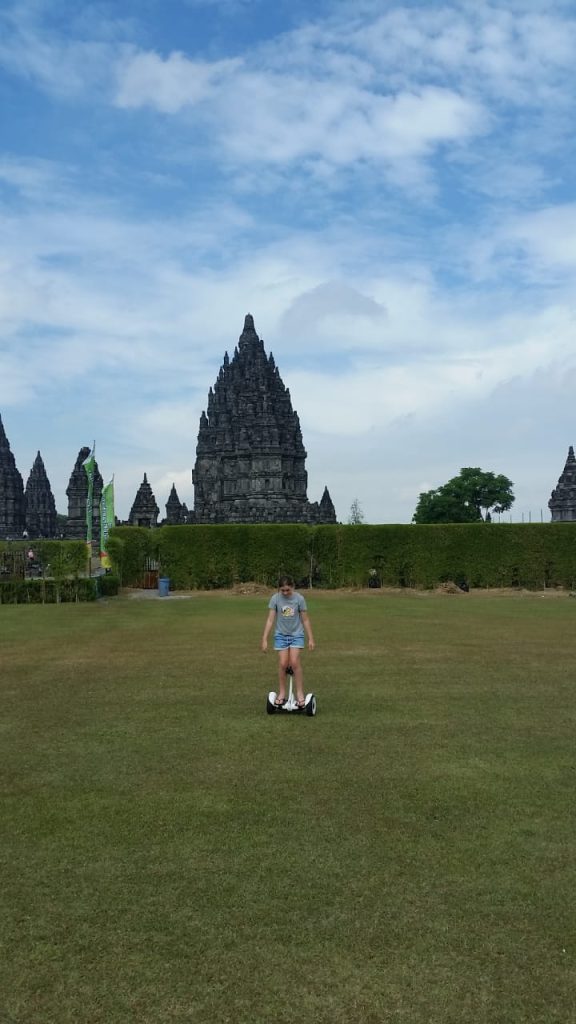

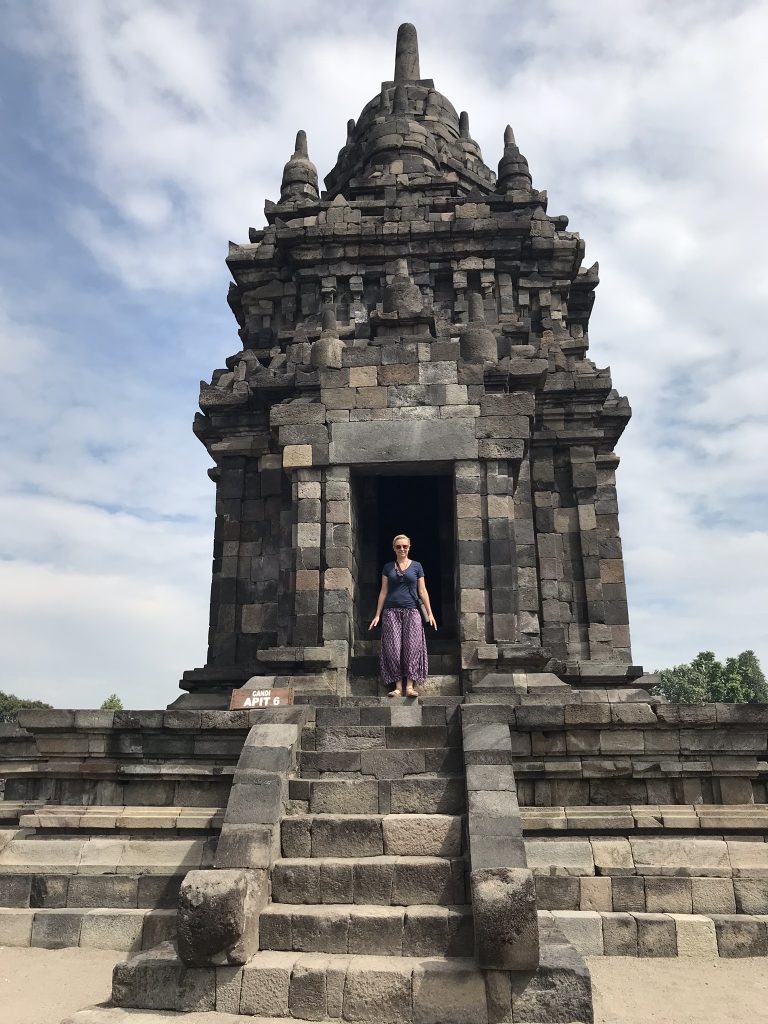






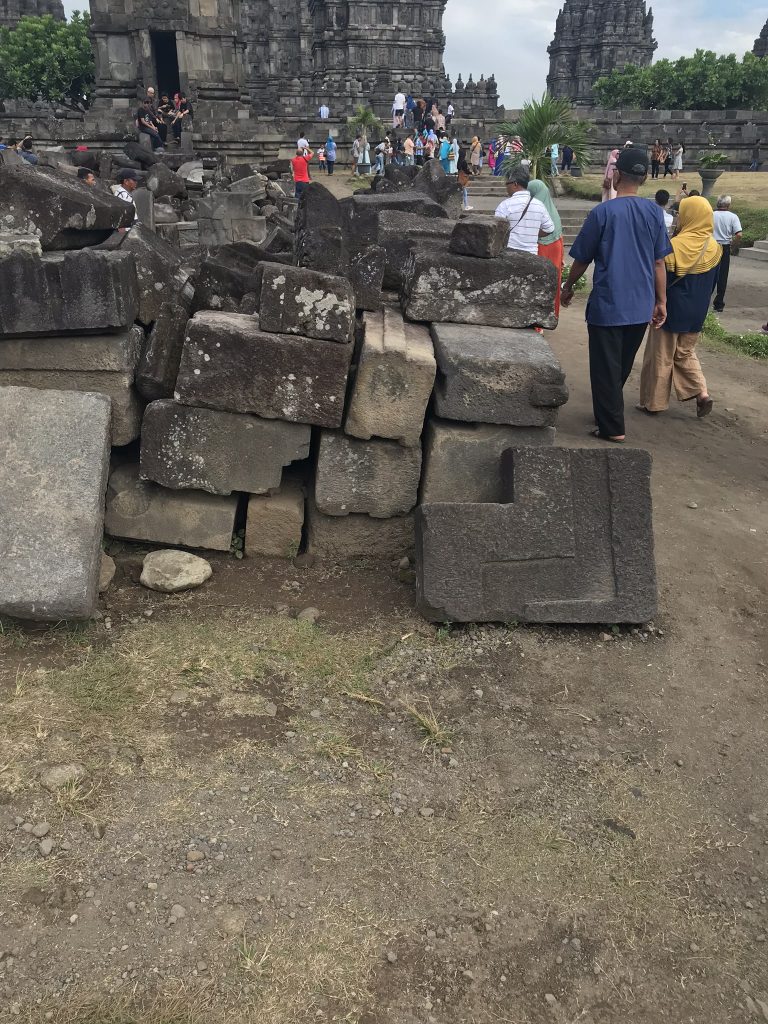

Gudeg
Many people in Bali come from Java, and when I was chatting to my students, the guy who fixes my computer, and my driver, they all recommended we try ‘Gudeg’ while we were in Yogyakarta.
There are entire streets dedicated to the dish; E and I decided to try it while on a little walk down Marliboro Street, the main thoroughfare. The traffic is hectic here; we prefer to walk to our food.
We left J at the barber’s; he was not keen on sitting cross-legged on a mat to eat.
Gudeg is a traditional Javanese cuisine from Yogyakarta and Central Java. Gudeg is made from young jackfruit, stewed for several hours with palm sugar, and coconut milk. Additional spices include garlic, shallot, candlenut, coriander seed, galangal, bay leaves, and teak leaves, the latter giving a reddish-brown colour to the dish. It is often described as “green jack fruit sweet stew”.
The sauce was spicy and the jackfruit was sweet and fleshy like a sweet potato. I have found the food here to be a lot sweeter than Balinese cuisine.
The waiter was very nice and gave us a spoon each: I did enjoy watching our dining neighbours pinch pieces of chicken off the bone, dab it into the rice with some sambal and eat teaspoonfuls at a time using their right hands. It is probably more hygienic that way- after passing the washing up trough on the way out I realised my spoon was probably dirtier than my fingers!

Gudeg was not to my taste- but it was way more appetising than the fish head concoction I was offered earlier in the day. The meat on the cheeks is actually quite flavoursome. It’s just not an aesthetically appealing dish. There are plenty of wonderful dishes to try in Indonesia- but once was enough on both accounts for us!

From Yogja we drove to the equally beautiful royal city of Solo (Surakarta) for the next part of our holiday- but that is a story for another blog post. Selamat Malam (goodnight) for now!


Leave a Reply